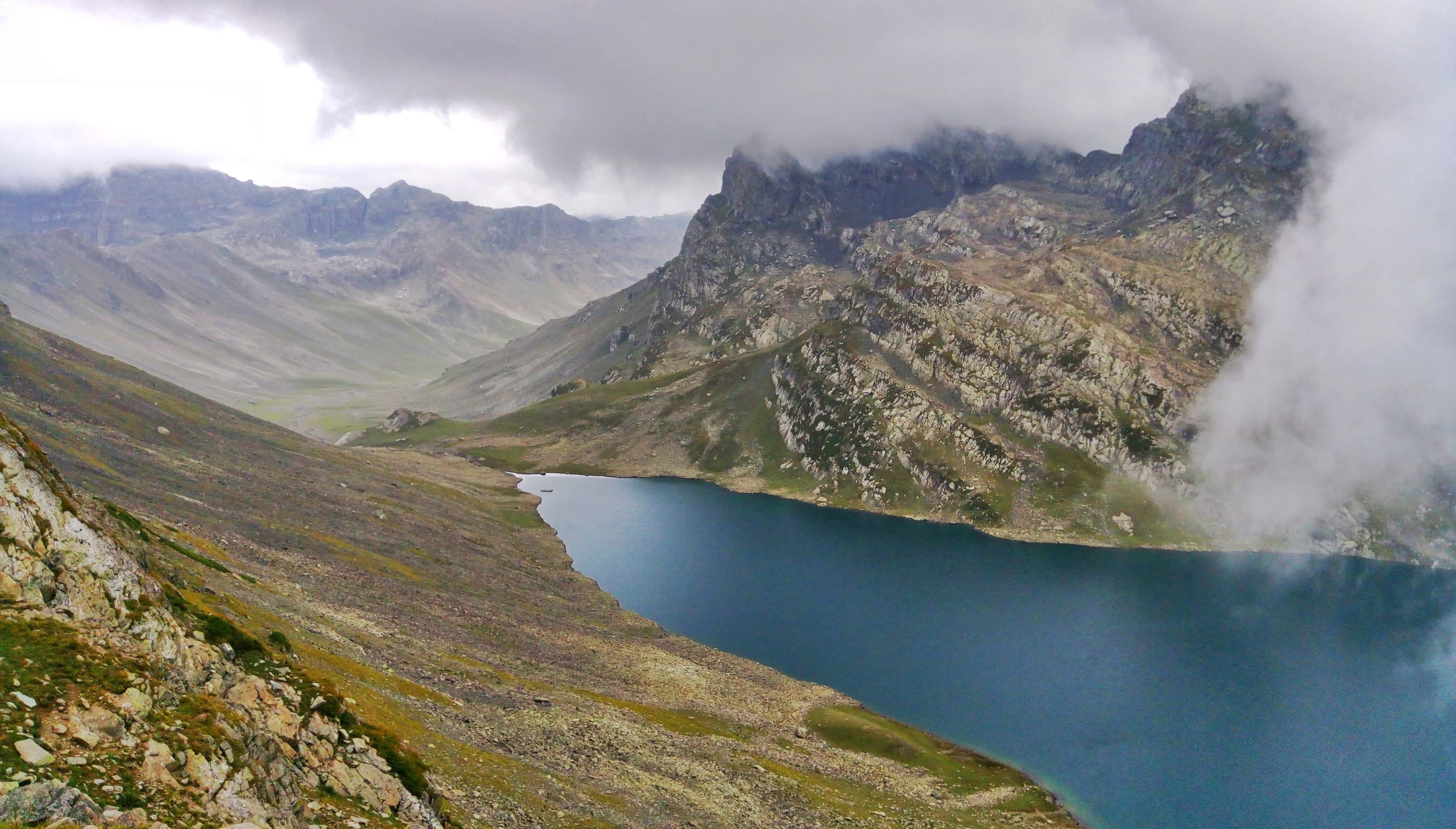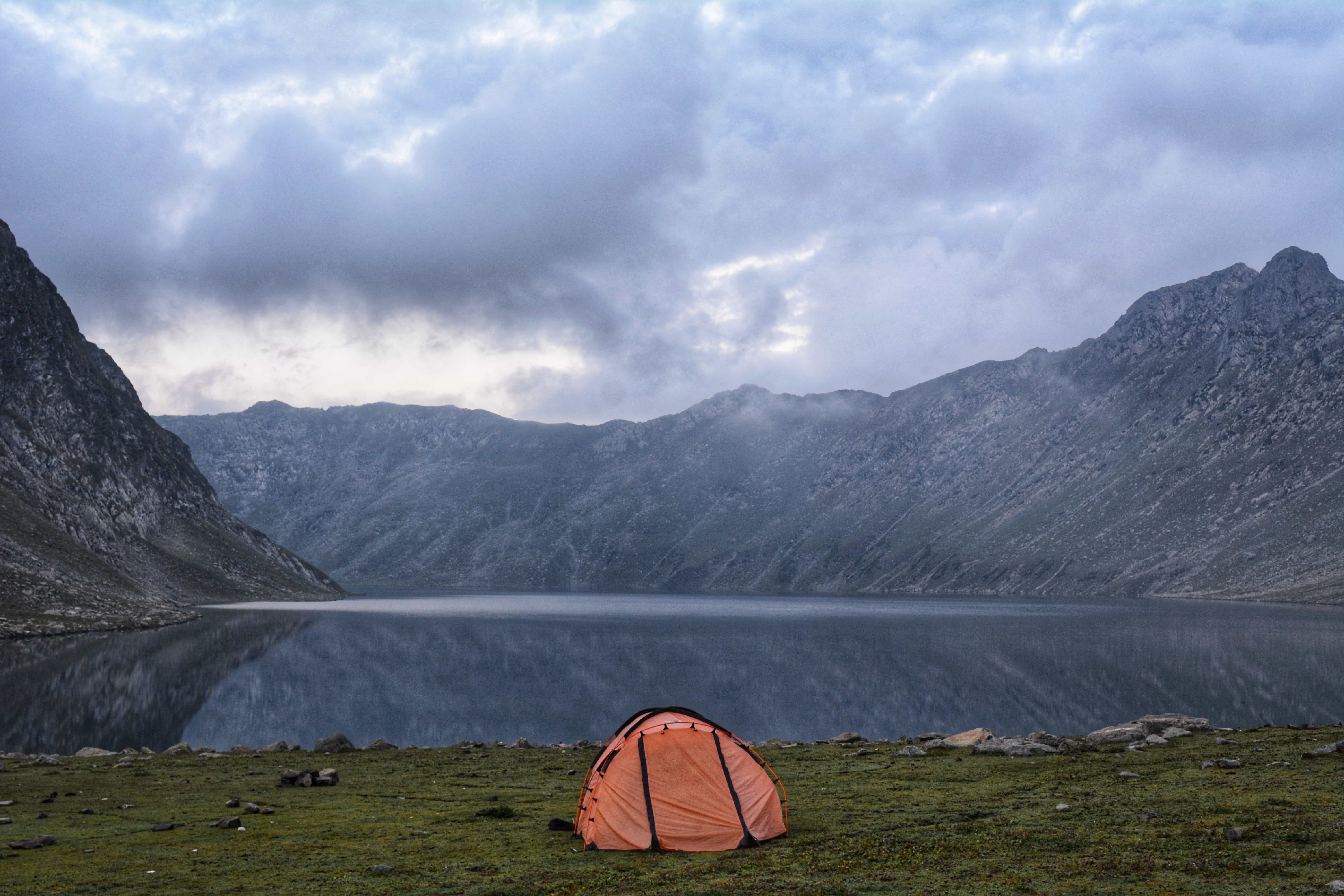The tarsar marsar trek is a breathtaking journey through the heart of Kashmir's majestic Kolahoi mountains, where alpine lakes take on a life of their own. This moderate-difficulty trek offers a chance to camp beside the royal blue, snow-fed Tarsar and Sundersar lakes, surrounded by secluded campsites – a true escape in today's crowded trekking scene.
You'll circumnavigate the perimeters of Tarsar and Sundersar, witnessing their grandeur from multiple vantage points, and even catch glimpses of the elusive Marsar lake hidden amidst the clouds. From quaint villages to rolling green mountains, this trek showcases the stunning visual splendor of Kashmir, leaving you awestruck for weeks.
Introduction to Tarsar Marsar Trek

Trek Overview
The Tarsar Marsar trek is a breathtaking journey that takes you to the heart of Kashmir's majestic Kolahoi mountains, where alpine lakes take on a life of their own. It is arguably one of the prettiest treks in India, rivaling its formidable sister trek, the Kashmir Great Lakes. This moderate-difficulty trek offers a chance to camp beside the royal blue, snow-fed Tarsar and Sundersar lakes, surrounded by secluded campsites – a true escape in today's crowded trekking scene.
Main Attractions
One of the main highlights of the Tarsar Marsar trek is the opportunity to circumnavigate the perimeters of Tarsar and Sundersar, witnessing their grandeur from multiple vantage points. You'll also catch glimpses of the elusive Marsar lake, often hidden under a shroud of clouds, from an overhang sitting 600–700 ft below. The trek takes you through quaint villages like Aru, clearings like Lidderwat, and rolling green mountains like Shekhawas, showcasing the stunning visual splendor of Kashmir.
Difficulty and Challenges
The Tarsar Marsar trek is considered moderate in difficulty compared to other Himalayan treks. It features a gradual ascent, with an average daily altitude gain of 1,000 to 1,500 feet, making it relatively easy on the legs. The trek covers an average of 5 km per day, with longer distances on the first and last days.
While the overall trek is not overly strenuous, there are a few challenging sections to be aware of. The descent from the Tarsar pass involves loose scree, which can cause slipping if not careful. Additionally, the boulder section after the Jagmargi meadows and the climb to the col between Sundarsar and Marsar can be tricky, especially in June when snow may make the terrain slippery. Proper footwear, trekking poles, and guidance from experienced trek leaders are recommended for these sections.
What to Pack
When preparing for the Tarsar Marsar trek, it's essential to pack the right gear and supplies to ensure a safe and enjoyable experience. Here's a comprehensive list of what you'll need:
Essential Clothing
- Moisture-wicking and quick-drying base layers (tops and bottoms)
- Insulating layers such as fleece jacket or down jacket for warmth
- Waterproof and windproof jacket and pants
- Trekking pants and shorts (quick-drying and breathable)
- Moisture-wicking socks and liners to prevent blisters
- Hat or cap for sun protection
- Gloves or mittens for cold weather
Trekking Gear
- Sturdy and comfortable trekking shoes with good grip
- Trekking poles for stability and support on uneven terrain
- Backpack with a rain cover to protect your gear from rain and moisture
- Sleeping bag suitable for cold temperatures (consider the weather conditions during your trekking season)
Emergency Supplies
- Sunscreen with high SPF
- Lip balm with SPF
- Sunglasses with UV protection
- Personal hygiene items (toothbrush, toothpaste, hand sanitizer, wet wipes, etc.)
- Lightweight and quick-drying towel
- Personal medications and first aid kit (including basic pain relievers, altitude sickness medication, bandages, blister plasters, etc.)
- Insect repellent
- Water bottles or hydration bladder (sufficient capacity to stay hydrated during the trek)
- Water purification tablets or filtration system
- High-energy snacks such as nuts, trail mix, energy bars, chocolate, etc.
- Instant noodles or ready-to-eat meals for quick and easy meals during the trek
- Lightweight and portable stove with fuel (if planning to cook meals)
- Map and compass or GPS device for navigation (along with the knowledge to use them)
- Headlamp or flashlight with extra batteries for nighttime visibility
- Whistle and signaling mirror for emergencies
- Multi-tool or Swiss army knife
- Emergency shelter or lightweight tent in case of unforeseen circumstances
- Camera or smartphone for capturing memories (with spare batteries or power bank)
- Trekking permits or necessary documentation required for the trek
- Cash in small denominations for emergency expenses
- Trash bags for carrying out waste and maintaining Leave No Trace principles
Pre-trip Health and Fitness
To participate in the Tarsar Marsar Trek, you must meet the following requirements: it is highly recommended that interested participants undergo a medical examination before embarking on the trek to ensure they are physically fit to undertake the journey.
Training Programs
1. Physical Fitness: The Tarsar Marsar Trek is a moderate to difficult level trek that requires a good level of physical fitness. It is recommended to start a moderate exercise routine at least 2-3 months before the trek to prepare your body for the physical demands of the trek. Cardiovascular exercises such as jogging, cycling, or swimming, as well as strength training, are highly recommended.
2. Trekking Shoes & Clothing: Invest in a good quality pair of trekking shoes that have good ankle support. Break in your shoes before the trek to prevent blisters and discomfort. In addition to the clothing items mentioned earlier, pack clothing that is lightweight, comfortable, and appropriate for trekking.
Health Tips
3. Altitude Sickness: The Tarsar Marsar Trek takes you to high altitudes. Altitude sickness is a common problem faced by many trekkers. Start taking proper precautions to acclimate to high altitudes at least a week before the trek. Stay hydrated and avoid alcohol and cigarettes. It is important to trek at a steady pace, take frequent breaks, and let your body adapt to the altitude.
4. Diet & Hydration: Maintain a healthy and balanced diet that includes carbohydrates and proteins. It is recommended to carry high-energy snacks such as chocolate bars, nuts, and energy bars to keep you going during the trek. Stay hydrated and carry plenty of water. Drinking boiled or filtered water is recommended.
Mental Readiness
5. Mental Preparation: Trekking requires mental fortitude and determination. Prepare yourself mentally for the trek by reading up on the trail, the physical demands of the trek, and the challenges you may face along the way. Positive thinking and a never-give-up attitude will help you overcome any obstacle during the trek.
The Tarsar Marsar trek is a safe trek with only a few difficult sections. Overall, it has a moderate level of difficulty. It is important to keep in mind and prepare for the tricky areas like descent on Tarsar pass, boulders beyond the Jagmargi meadow, col on Sundarsar to Marsar crossing and a long descent on the last day.
Permits and Reservations

Yes, permits or permissions are typically required for the Tarsar Marsar Trek, which is located in the Kashmir region of India. As the trek passes through protected areas and involves camping in designated zones, obtaining the necessary permits is essential.
Permit Requirements
- Trekking Permit: Trekkers usually need a trekking permit to undertake the Tarsar Marsar Trek. This permit is typically obtained through registered trekking agencies or the local tourism department. It's essential to check with the relevant authorities or your trekking agency to ensure that you have the necessary permits before starting the trek.
- Entry Permit: Since the Tarsar Marsar Trek may pass through certain restricted or controlled areas, an entry permit might be required for accessing the trekking route. This permit can usually be obtained from the local administration or forest department. Make sure to inquire about entry permit requirements and procedures well in advance of your trek.
- Identification Documents: Along with permits, you'll likely need to carry valid identification documents such as passports, voter ID cards, or Aadhaar cards. These documents may be required for verification purposes during permit issuance or while trekking in the region.
- Camping Permit: Since camping is an integral part of the Tarsar Marsar Trek, trekkers may need to obtain camping permits for specific campsites along the route. These permits are typically arranged by trekking agencies or obtained from the local authorities responsible for managing the trekking area.
- Local Guidelines and Regulations: Always adhere to any local guidelines, regulations, or restrictions imposed by the authorities or local communities while trekking in the Tarsar Marsar region. Respect cultural norms, environmental conservation efforts, and any rules designed to protect the region's fragile ecosystem.
- Trekking Agency Assistance: If you're trekking with a reputable trekking agency, they will typically handle the permit application process on your behalf. They'll ensure that all necessary permits are obtained before the trek begins, alleviating any concerns regarding paperwork or bureaucratic procedures.
Booking Transportation
To reach Aru Valley, the starting point of the Tarsar Marsar Trek, it will take around 4-5 hours if you take a direct shared taxi from Srinagar. The last ATM is in Pahalgam itself, so it's recommended to withdraw money in Srinagar, where you'll have more ATM options.
Per taxi costs about INR 2,500-2,700. If there are six people in one cab, it could easily come down to INR 420 per person one way. The travel from Srinagar to Aru Valley and back can be done for around INR 1,000 per person.
Reserve Campsites
You can get a number of options for the Tarsar Marsar trek, and each package varies from one another. The entire package from Aru Valley and back, which includes accommodation in Aru Valley, camps during all the days, three times meals every single day, tea, sleeping bags, etc., costs between INR 12,000 to INR 15,000 depending on which company you book with.
It's crucial to stay updated on the latest permit requirements and regulations for the Tarsar Marsar Trek, as these may change over time due to factors such as security concerns, environmental conservation efforts, or administrative decisions. Always consult with your trekking agency or local authorities for the most accurate and up-to-date information regarding permits and permissions.
Conclusion

The Tarsar Marsar Trek offers a unique opportunity to immerse yourself in the awe-inspiring beauty of Kashmir's alpine lakes and rolling green meadows. With proper planning, packing the right gear, and maintaining physical and mental preparedness, you can embark on this moderate-difficulty trek with confidence. From witnessing the grandeur of Tarsar and Sundersar lakes to catching glimpses of the elusive Marsar, this trek promises a visual feast that will leave you spellbound.
The memories of camping under starry skies, trekking through quaint villages, and navigating the challenging sections of the trail will stay with you long after the trek. To experience the magic of Tarsar Marsar, contact Bikat Adventures to book your trek and create unforgettable memories in the heart of Kashmir's majestic Kolahoi mountains.
FAQs
1. How challenging is the Tarsar Marsar trek?
The Tarsar Marsar Trek, situated at an elevation of 4,000 meters, is considered a moderate-level trek. It is generally suitable for individuals who have some prior experience trekking at high altitudes.
2. Is it possible to undertake the Tarsar Marsar trek alone?
The trek spans 6 nights and 7 days, starting from Aru Valley and ending in Sumbal Sonamarg. If an additional day is included, trekkers can also explore two more alpine lakes, Yamsar and Khemsar. Solo trekkers can find more information on arranging a private Tarsar Marsar trek.
3. What is the easiest lake trek in Kashmir?
The Tarsar Marsar Trek is considered one of the easiest lake treks in Kashmir. It features a route that includes camping near picturesque lakes, making it accessible and enjoyable for both beginners and experienced trekkers.
4. Can you swim in Tarsar Lake?
Tarsar Lake, one of the largest high-altitude lakes in Kashmir, is located at approximately 12,000 feet. Swimming in its bone-chilling waters can be an exhilarating experience for those who dare.














